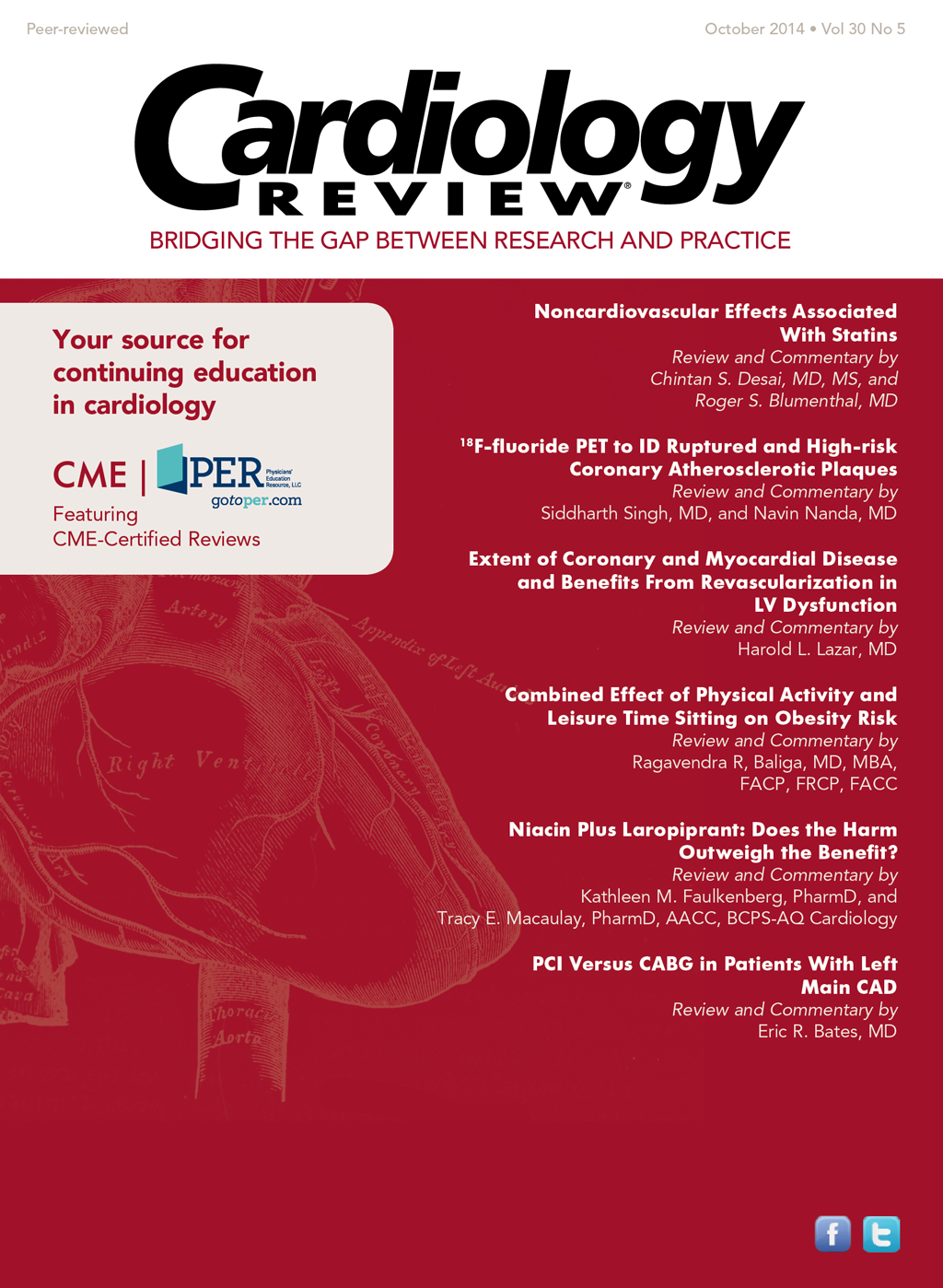Publication
Article
Cardiology Review® Online
What is the Role of Beta-blockers in Patients Treated with Primary Percutaneous Coronary Intervention
In this edition of Clinical Forum, we asked 3 Cardiology Review editorial board members to comment on the role of beta-blockers in patients treated with primary percutaneous coronary intervention.
In this edition of Clinical Forum, we asked 3 Cardiology Review editorial board members to comment on the role of beta-blockers in patients treated with primary percutaneous coronary intervention (PCI).
Please send your comments or suggestions for future Cardiology Review Clinical Forum questions to Dr Mukherjee at debabrata.mukherjee@ttuhsc.edu. Space permitting, we will post them online and in the iPad edition of the next issue.
Q: What is the role of beta-blockers in patients treated with primary PCI?
Hitinder S. Gurm, MD
Associate Professor of Internal Medicine
Director, Inpatient Cardiology Services
Director, Carotid Interventions in Cardiovascular Medicine
Division of Cardiovascular Medicine
University of Michigan Ann Arbor, MI

Hitinder S. Gurm, MD
Current American College of Cardiology/ American Heart Association and European Society of Cardiology guidelines for the care of ST-elevation myocardial infarction (STEMI) provide a strong endorsement of the use of beta-blocker therapy, and administration of beta-blocker therapy after STEMI is considered an important quality measure.
1
The initial data supporting the benefit of beta-blocker therapy emerged nearly 3 decades ago and consisted of animal models and human studies in the prefibrinolysis era.
2
These studies demonstrated a reduction in infarct size and improvement in clinical end points with early administration of intravenous beta-blocker therapy in animal models of STEMI as well as in patients presenting with STEMI.
3
A:
Data supporting the benefit of beta-blockers among patients treated with fibrinolytics have been broadly neutral. In the TIMI-IIB (Thrombolysis in Myocardial Infarction II-B) trial, early intravenous metoprolol followed by oral therapy failed to demonstrate any benefit over deferred oral beta-blocker initiated on day 6.
4
In the Clopidogrel and Metoprolol in Myocardial Infarction Trial (COMMIT), 45,852 patients within 24 hours of suspected STEMI were randomized to intravenous and continued oral metoprolol or placebo.
5
Randomization to metoprolol was associated with a reduction in reinfarction and ventricular fibrillation, which was countered by an increase in cardiogenic shock and hypotension. There was no difference in mortality. Based on the results of these trials and in the absence of the data to the contrary, it is clear that routine intravenous beta-blockers have no value in the management of STEMI patients who are treated with fibrinolytics.
Similarly, the impact of long-term beta-blocker therapy after MI has been studied predominantly in the prefibrinolytic era. These studies demonstrated improvement in long-term survival (30-36 months) with continued beta-blocker therapy.
6
Subsequent subgroup analysis suggested that the benefit of beta-blockers was most evident in patients with low ejection fraction. The role of beta-blockers in patients with low ejection fraction in the setting of contemporary heart failure medications was established by the CAPRICORN trial.
7
Compared with placebo, treatment with carvedilol (initiated on a background of statins and angiotensin-converting-enzyme [ACE] inhibitors) was associated with a reduction in all-cause and cardiovascular mortality.
7
The magnitude of benefit associated with beta-blockers in this trial was consistent with that seen in prior trials.
Currently, primary percutaneous coronary intervention (PCI) is the predominant reperfusion strategy for STEMI in the United States. Primary PCI is associated with very high rates of patent infarct-related artery, and restoration of TIMI-3 flow and successful PCI is associated with markedly low mortality and morbidity. The magnitude and nature of cardiac injury after primary PCI is very different from that seen after fibrinolytic therapy or after a completed infarct. The role for beta-blockers in the primary PCI population has never been specifically evaluated in randomized trials. Post hoc analysis from randomized trials and registries suggests that patients who either were on chronic beta-blockers or received beta-blockers in the emergency department had a lower incidence of ventricular fibrillation and possibly mortality.
8,9
One must be cautious in extrapolating these data to clinical practice because the use of beta-blockers is potentially confounded by indication, and patients who received beta-blockers were potentially less sick compared with the rest. Furthermore, given the potential for harm associated with intravenous beta-blockade in the COMMIT trial, intravenous beta-blockers should be avoided in this population. The long-term benefits of beta-blockers are probably extant among patients treated with primary PCI, although the absolute benefit is probably maximal in patients with a low ejection fraction. Oral beta-blockade should be initiated on the second day after primary PCI and the dosage increased slowly. It is unclear how long beta-blocker therapy should be continued after primary PCI. Among patients with low ejection fraction, it is reasonable to continue beta-blocker therapy indefinitely. Among patients with a normal ejection fraction, current guidelines recommend beta-blocker therapy for 3 years, although this recommendation is not based on hard data.
1
In my practice, beta-blockers are continued for at least 3 years in this population, albeit with a low threshold to stop this treatment sooner if the patient has any adverse effects.
REFERENCES
1. O’Gara PT, Kushner FG, Ascheim DD, et al. 2013 ACCF/ AHA guideline for the management of ST-elevation myocardial infarction. Executive summary: a report of the American College of Cardiology Foundation/American Heart Association Task Force on practice guidelines. J Am Coll Cardiol. 2013;61:e78-e140.
2. Rasmussen MM, Reimer KA, Kloner RA, Jennings RB. Infarct size reduction by propranolol before and after coronary ligation in dogs. Circulation. 1977;56:794-798.
3. Timolol-induced reduction in mortality and reinfarction in patients surviving acute myocardial infarction. N Engl J Med. 1981;304:801-807.
4. Roberts R, Rogers WJ, Mueller HS, et al. Immediate versus deferred beta-blockade following thrombolytic therapy in patients with acute myocardial infarction. Results of the thrombolysis in myocardial infarction (TIMI) II-B study. Circulation. 1991;83:422-437.
5. Chen ZM, Pan HC, Chen YP, et al. Early intravenous then oral metoprolol in 45,852 patients with acute myocardial infarction: randomised placebo-controlled trial. Lancet. 2005;366:1622-1632.
6. Freemantle N, Cleland J, Young P, Mason J, Harrison J. Beta blockade after myocardial infarction: systematic review and meta regression analysis. BMJ. 1999;318:1730- 1737.
7. Dargie HJ. Effect of carvedilol on outcome after myocardial infarction in patients with left-ventricular dysfunction: the CAPRICORN randomised trial. Lancet. 2001;357:1385-1390.
8. Halkin A, Grines CL, Cox DA, et al. Impact of intravenous beta-blockade before primary angioplasty on survival in patients undergoing mechanical reperfusion therapy for acute myocardial infarction. J Am Coll Cardiol. 2004;43:1780-1787.
9. Valle JA, Zhang M, Dixon S, et al. Impact of pre-procedural beta blockade on inpatient mortality in patients undergoing primary percutaneous coronary intervention for st elevation myocardial infarction. Am J Cardiol. 2013;111:1714-1720.






